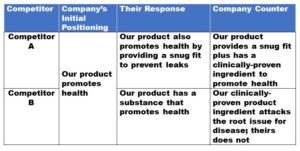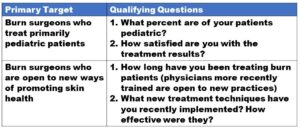As an old movie buff, and someone who’s read the complete works of Sherlock Holmes, I loved to watch Basil Rathbone play the part. Although he didn’t coin it, Holmes lived by the phrase, “There’s more to it than meets the eye.” And as a result, he was the preeminent detective, solving challenging crimes perpetrated by cunning criminals.
When it comes to writing the Marketing Plan (MP), preeminent marketers add more than the basic plan components. And as a result, they develop a MP that provides greater business impact. This article discusses a few advanced MP concepts.
Important Objectives
Everyone sets financial objectives in the MP, but two other objective types should be considered: 1) qualitative business objectives (QBO), and 2) customer objectives (CO).
Since products have more than a financial impact on the corporation; it only makes sense to incorporate QBOs into the MP. This objective type exposes important corporate benefits that can achieved by following the plan. Once identified they can be monitored and addressed if results lag expectations. QBOs provide focus for the commercial activities that must be implemented.
Common QBOs include: achieving market share goals, establishing a presence in a new market, accessing a new customer base, or enhancing the company’s image. Select those QBOs that are most impact the business.
A successful business relationship with customers is predicated on a win-win situation for both parties. Therefore, describing how the customer benefits as part of the MP is important for setting the stage for successful customer transactions. COs define how the customer wins either by the value delivered or the key product benefits that the customer obtains. When developing these objectives, make sure to target all buyer types – clinical, user or financial.
Identifying customer objectives up front helps in developing other elements of the MP. COs will guide product positioning, messaging, advertising, marketing programs and sales collateral. After all, what better way to attract customers than to explain how they win from the exchange? Some sample COs include:
- Reducing the frequency and / or severity of complications
- Addressing the side effects of competitive products
- Improving the clinical workflow associated of disease treatment
- Improving cost effectiveness
Positioning
A common mistake of technically oriented entrepreneurs is focusing market communication on product features, rather than what customers truly value, product benefits. The customer purchase decision is based on the question, “What’s in it for me?” Unfortunately, feature descriptions fail to answer this question. Benefits drive value in the mind of the customer and therefore should be explained. Leaving them for the customer to uncover is just bad marketing.
Targeting
Even the most basic MPs identify customer targets, but since only a few targets are likely to buy immediately, the MP needs to identify early adopters. Since driving sales traction is critical for commercial success, the MP needs to explain how the sales team can identify these initial targets.
Start by developing criteria for customer primary (early adopter) and secondary targets. Then use this list of primary target characteristics to develop qualifying questions that Sales can use to identify primary targets. The table below provides an example. 
Messaging
Some messages are easy for the customer to understand, while others are not. Neglecting to evaluate which messages are intuitively obvious and which are not can reduce campaign effectiveness.
Intuitive messaging needs no further explanation by the company. Customers accept the message at face value. However, the intuitively obvious message is often less powerful for driving purchasing behavior. Consider for instance the intuitive message, “Infections need to be prevented.” No clinician would argue this point. But this statement doesn’t drive the purchase decision on any particular brand.
Less obvious messaging requires in-depth explanations; that is why the MP should identify the supporting arguments, often clinical education collateral. This messaging facilitates purchase behavior because it drives dialogue and engagement. It can capture attention and force customer evaluation. Consider the unintuititve message. “A high percentage of patients using current standards of care experience avoidable infections.” This statement introduces concepts that can drive engagement that paves the way for purchasing the product.
Marketing tactics
Here is a list of advanced marketing tactics to consider:
- Companies can get more out of tradeshows than just managing booth traffic. Improve tradeshow effectiveness by preselling the product through pre-meeting email blasts or intra-meeting Twitter notices. Sponsor posters and presentations by clinicians experienced with the company’s product. Or, fund virtual exhibits that remain active long after meeting completion.
- Create user groups that can uncover hidden issues, provide feedback on effective positioning or messaging, or identify educational or selling programs that could drive market share.
- Ensure that cost effectiveness promises truly deliver savings. Many companies attempt to justify cost by offering pseudo savings. Usually, these savings are based on staff time savings. But labor cost is only reduced when headcount is reduced. Saving one or two nurse hours per day, only allows additional tasks to be completed. Therefore, only out-of-pocket costs like supply reductions are true cost savings. This data is often necessary for payors to approve reimbursement.
- As an alternative to cost effectiveness, consider messaging that enhances revenue or avoids payor quality penalties and revenue reductions. For instance, perhaps your product can reduce 30-day readmissions. Any message needs clinical data validation, which is only possible by incorporating it into the clinical trial design.
- Unfortunately, the typical sales brochure is often ignored by clinicians. Rather than create emotional appeal messaging, consider educational collateral that caters to the fact-based decision-making persona of clinicians. Clinical trial data is especially valuable and if presented without marketing hyperbole can be especially effective.
- Consider developing a pre-launch awareness campaign. Many organizations neglect this technique because of the pre-approval marketing restrictions placed by regulatory bodies. However, there are many product barriers besides the product that could be addressed in an awareness campaign: e.g., misunderstanding of the underlying factors contributing to the clinical condition, clinical outcome concerns, diagnosis difficulties or shortcomings of current treatment protocols. Each topic can be addressed without mentioning product and attracting regulatory attention. This approach can stimulate demand and accelerate adoption when the product is available.
Competition management
An advanced MP does more than just lay out the company position for a product. It is designed knowing the competition’s message and how they would respond to yours. It’s valuable to develop a counter-message to the competition’s expected response so the sales team is prepared. An example is provided in the table below.

Conclusion
Like Sherlock Holmes’ efforts in solving a criminal mystery is based on the phrase, “There’s more to it than meets the eye,” so too does this phrase guide our MP efforts. There is so much more we can accomplish by incorporating more than just the basics to our MP. These tips can lead to even greater success.

